A provider is a centrally configured resource that supplies
services to run time components in the server. For example, a keystore
provider centralizes the definition of one security keystore, including
its type, file location, and password. Each configured provider
has a name. Using that name the services of the provider can be
referenced in other parts of the server.
One provider can refer to another provider. The SSL provider,
as an example, requires a keystore and a trust store. Each of these
is a keystore of some type, so instead of configuring all of the
details of the keystore, the configuration simply asks for the name
of the keystore provider(s) in charge of the keystore and trust
store.
Often, several providers can supply the same service, although
in different ways. For example, in a secure system a certificate
can be stored in a keystore or in an LDAP directory. A Certificate
Revocation List (CRL) can be stored in a file system directory or
in an LDAP directory. Simply specifying the name of the provider
to be used to access the certificate or the CRL is all that is needed
when configuring for a need. This simplifies server configuration.
A provider describes a resource available at run time, while
the users of the provider are configured in the design time experience;
a deployed usage is tied to the run time physical implementation
only by its name. For example, a configuration requiring a certificate
store can be deployed on servers having completely different storage
for its certificates.
Please note that the term providers is used on several levels.
While the providers available in iWay Service Manager offer services
to other iWay components, providers can also refer to software that
is installed into the Java Virtual Machine (JVM) that provides services
to application programs. These JVM providers must also be configured.
x
The Data Provider option enables you to define and configure
data servers and connections. The data provider properties include:
- JDBC connections
- JLINK to access
iWay, WebFOCUS, and EDA data servers
x
Procedure: How to Add a JDBC Connection
To
add a JDBC connection:
-
In the
left console pane of the Server menu, select Data Provider.
-
Beneath
the JDBC section, click Add.
The JDBC Data Provider Definition pane displays.
-
Provide the appropriate values for your JDBC connection
as listed and defined in the following table.
|
Parameter
|
Description
|
|---|
|
JDBC Connection Pool Properties
|
|
Name *
|
Enter the name of the JDBC data provider
to add.
|
|
Driver Class
|
The JDBC driver class is the name of the
class that contains the code for this JDBC Driver. You can select
a predefined database from the drop-down list or enter your own.
The
following are sample values for the driver:
com.microsoft.jdbc.sqlserver.SQLServerDriver
COM.ibm.db2.jdbc.app.DB2Driver
com.informix.jdbc.IfxDriver
sun.jdbc.odbc.JdbcOdbcDriver
oracle.jdbc.driver.OracleDriver
com.sybase.jdbc2.jdbc.SybDriver The required .jar
files for the JDBC driver must be installed and registered in the
Service Manager classpath. You can use the Path Settings option
on the console to add Java classes and libraries. |
|
Connection URL
|
The JDBC connection URL to use when creating
a connection to the target database. The URL generally includes
the server name or IP address, the port or service, the data source
name, and a driver specific prefix. You can select a predefined
database from the drop-down list or enter your own.
The following
are sample values for the URL:
jdbc:microsoft:sqlserver://server:1433;DatabaseName=DB
jdbc:db2:database
jdbc:informix-sqli://HOST:PORT/DB:INFORMIXSERVER=SERVER_NAME
jdbc:odbc:DBjdbc:oracle:thin:@HOST:PORT:SIDjdbc:sybase:Tds:HOST:PORT For
more information, see the JDBC documentation for the specific data
source. |
|
User
|
User name with respect to the JDBC URL and driver.
|
|
Password
|
Password with respect to the JDBC URL and driver.
|
|
Connection Pool Properties
|
|
Initial Pool Size *
|
Number of connections to place in the pool
at startup.
|
|
Maximum Number of Idle Connections *
|
Maximum number of idle connections to retain
in the pool. 0 means no limit except what is enforced by the maximum
number of connections in the pool.
|
|
Maximum Number of Connections *
|
Maximum number of connections in the pool.
0 means no limit.
|
|
Login Timeout
|
Time in seconds to wait for a pooled connection before
throwing an exception. 0 means wait forever.
|
|
Behavior When Exhausted
|
What to do when the pool reaches the maximum number
of connections. Block means wait for a connection to become available
for the period defined by the login timeout parameter. Fail means
throw an exception immediately.
|
|
Validation SQL
|
SQL statement that can be executed to validate
the health of a pooled connection. The statement should return a
result set of at least one row.
|
|
Validate on Borrow
|
If set to true, the
validation SQL statement will be executed on a pooled connection before
returning the connection to the caller.
|
|
Validate on Return
|
If set to true, the
validation SQL statement will be executed on a pooled connection before
replacing the connection in the pool.
|
-
Click Test to
check for proper connections.
If a connection cannot be made, an error message displays
describing the problem. Typically, the driver has not been installed
or the classpath has not been set.
-
Click Add to
return to the Data Provider pane.
x
Procedure: How to Add a JLINK Data Source
To
add a JLINK data source:
-
In the
left console pane of the Server menu, select Data Provider.
-
Beneath
the JLINK section, click Add.
The JLink pane displays.

-
In the
Name field, type the name of a new server. In this example, type NEWSERV.
-
In the
Description field, type a brief description for the new server.
The default is JLINK Data Provider.
-
From
the Type drop-down list, select a JLINK server type.
The default is WebFOCUS Pro Server.
-
Type
the required values for Host and Port.
-
Type
the required values for User and Password.
-
From
the Engine drop-down list, select a database engine.
The default is 0 (EDA).
-
From
the Encoding drop-down list, select a codepage.
The default value is 137 (U.S. English).
-
To encrypt
data that is transported over the wire (optional), select the Encryption check
box.
-
In the
Trace File field, type the path and name of the file for the trace output.
-
To set
trace levels, select any number of the check boxes listed (optional).
-
Click Add.
x
iWay Service Manager can quickly and easily expose iWay
Business Services as Web Services through the iWay Business Services
Provider (iBSP).
iWay Business Services Provider is installed with an embedded
HSQL repository, which is the default data store for information
that is generated during design time and then published into a deployed
run-time environment. HSQL is an open source Java based SQL relational
database engine and includes a JDBC driver.
iBSP uses defined services providers to integrate with available
data repositories. If a repository is not defined, the default HSQL
repository is assumed by iWay Service Manager.
A repository migration facility is also included, which provides
portability for your existing metadata and iWay Business Services.
For example, you can migrate your data between development, testing,
and production environments across multiple systems. For more information,
see Migrating Repositories.
The settings in the Services Provider pane refer to the configuration
of the iWay Business Services Provider in the base configuration
of the server.
x
Procedure: How to Configure Services Provider Settings
The
Services Provider pane enables you to define properties required
to support iWay business services as Web Services.
To configure
for a Web service:
-
In the
left console pane of the Server menu, select Services
Provider.
The Services Provider pane opens, as shown in the following
image.
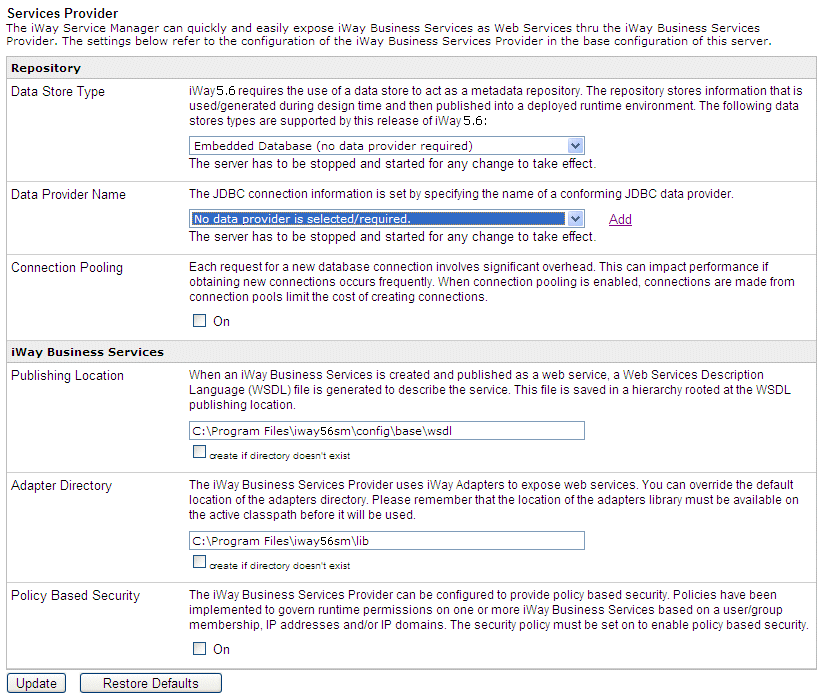
-
From
the Data Store Type drop-down list, select a repository you want to
configure.
The following are available:
- Embedded Database
(no data provider required)
- File System
(no data provider required)
- IBM DB2
- MaxDB
- Microsoft SQL
Server
- Oracle
- Sybase
You
must configure the tables before using the repository. For more
information on configuring repository tables, see the iWay
Installation and Configuration Guide.
Note: iWay
Service Manager is installed with an embedded HSQL repository, which
is the default data store for information that is generated during design
time and then published into a deployed runtime environment.
For
more information on the properties on this window, see the table
in Services Provider Settings.
-
From
the Data Provider Name drop-down list, select an available data provider.
For more information on how to add a data provider, see How to Add a Data Provider.
-
Type
new values or modify existing values.
-
Click Update.
x
Reference: Services Provider Settings
The
following table lists and describes the Services Provider settings.
|
Property
|
Type/Value
|
Description
|
|---|
|
Data Store Type
|
Choice
|
Acts as a metadata repository.
The default value is Embedded Database. Select a database from the
drop-down list: File System (not supported for production use),
IBM DB2, MaxDB, Microsoft SQL Server, Oracle, and Sybase.
|
|
Data Provider Name
|
String
|
JDBC driver defined in the
Data Provider pane. Select from the drop-down list, or click Add
to define a new JDBC connection.
|
|
Connection Pooling
|
Boolean
|
When selected, turns on connection
pooling for the JDBC driver.
|
|
Publishing Location
|
Directory
|
Directory where the WSDL files
produced by the iWay Business Services Provider (iBSP) are stored.
If the directory does not exist, select the check box to create
the named directory.
|
|
Adapter Library
|
Directory
|
Directory where the iWay adapter
JAR files are located. If the directory does not exist, select
the check box to create the named directory.
|
|
Policy Based Security
|
Boolean
|
When selected, enforces iBSP security policy.
For more information, see the iWay Business Services Provider User's
Guide.
|
x
Procedure: How to Add a Data Provider
To
add a data provider:
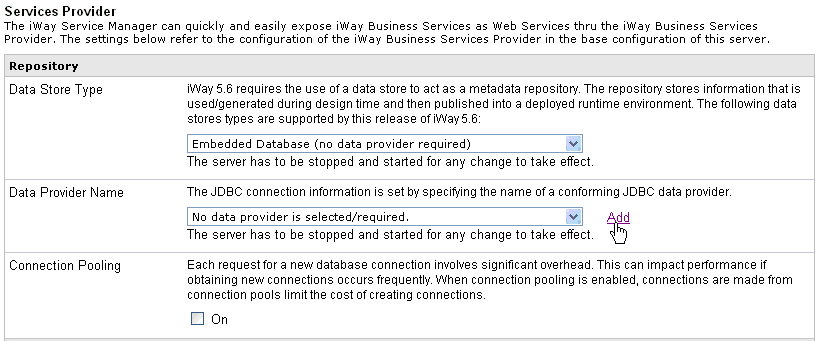
-
Click Add in
the Data Provider Name section.
The Data Provider - JDBC pane opens.
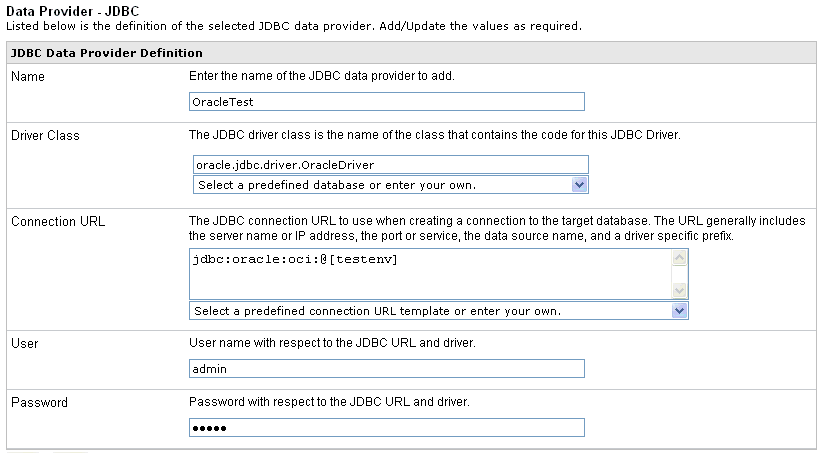
-
Enter
a name for the JDBC data provider.
-
From
the Driver Class drop-down list, select the JDBC class for the data provider.
You can also manually enter the name.
-
From
the Connection URL drop-down list, select the connection URL to use
when creating a connection to the target database.
You can also manually enter the URL.
-
Enter
the user ID to access the repository database.
-
Enter
the password to access the repository database.
-
Click Test.
You should receive a response that says:
The JDBC data provider test completed successfully.
If
you receive an error, troubleshoot accordingly. Ensure the driver
is in the iWay60\lib directory. For more information, see the iWay
Installation and Configuration Guide.
-
Click Update if
the test is successful.
You connection appears on the Data Provider pane. If you
need to change its parameters, you can click the name of the connection.
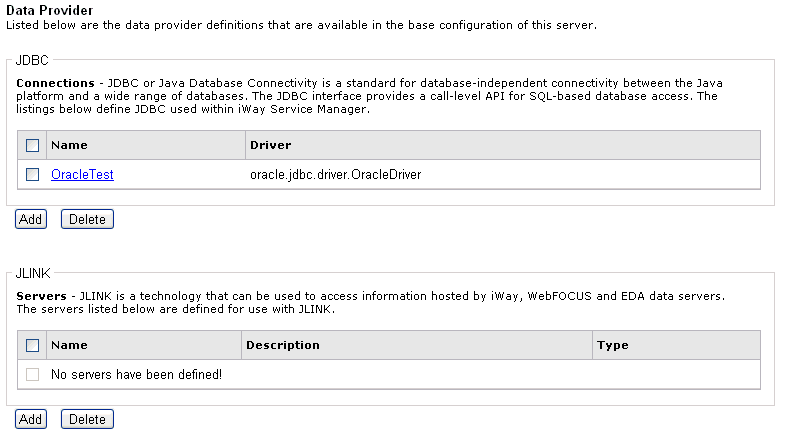
If you need to define
both the target and source repositories, repeat this procedure to
define another repository.
x
You can migrate repositories using the iWay Service
Manager Administration Console. These repositories can be for iWay
Service Manager, the older iWay Adapter Manager, Servlet iBSP, or
iWay Connector for JCA. The structure of the repository has not
changed.
Some of the things you can migrate include:
- Migrate the
data in the default iWay SM HSQL database to another database repository.
- Migrate an
older iWay Adapter Manager repository into the default iWay SM HSQL database.
- Migrate a Servlet
iBSP or iWay Connector for JCA database repository.
Note: Monitoring tables are not migrated.
In this section:
-
Source repository
refers to the older existing repository you wish to migrate.
-
Target repository
refers to the new repository you wish to use.
x
The following steps are required to migrate a repository:
- Ensure you
have created the new repository tables. For more information, see the iWay
Installation and Configuration Guide.
- Ensure the
JDBC driver for your target and source repositories are in the iWay60\lib directory.
For more information, see the iWay Installation and Configuration Guide.
- Define the
source and target repositories as Data Providers using the iWay
Service Manager Administration Console as explained in How to Add a Data Provider.
- Start the migration
as explained in How to Migrate a Repository.
x
Procedure: How to Migrate a Repository
To
migrate a repository:
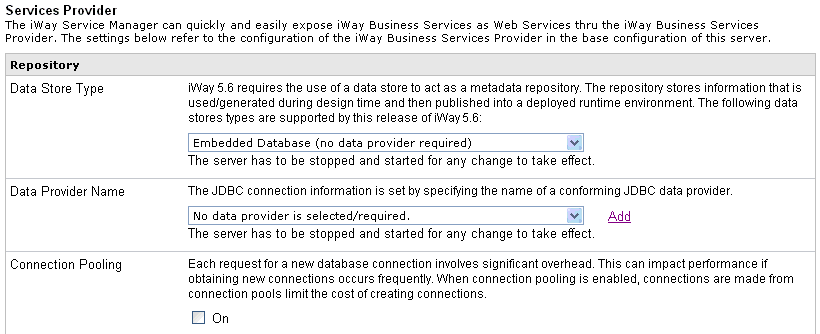
-
Click Services
Provider in the left pane.
The currently selected Data Store Type and Data Provider
Name determine the source repository.
-
Set
the source repository by selecting the Data Store Type and Data
Provider Name, and clicking Update.
The Data Provider Name is the name you used when you defined
the source repository.
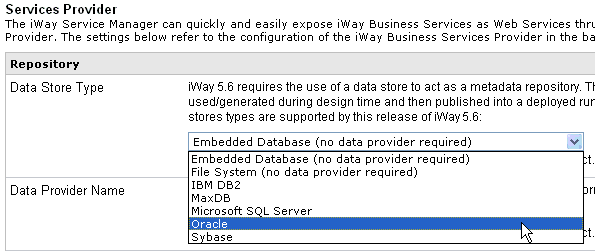
-
Set
the target repository by selecting a repository you want to migrate, for
example, Oracle, from the Data Store Type drop-down list.

-
From
the Data Provider Name drop-down list, select the name of the data
provider, for example, OracleTest.
The Repository section in the Services Provider pane refreshes,
as shown in the following image.
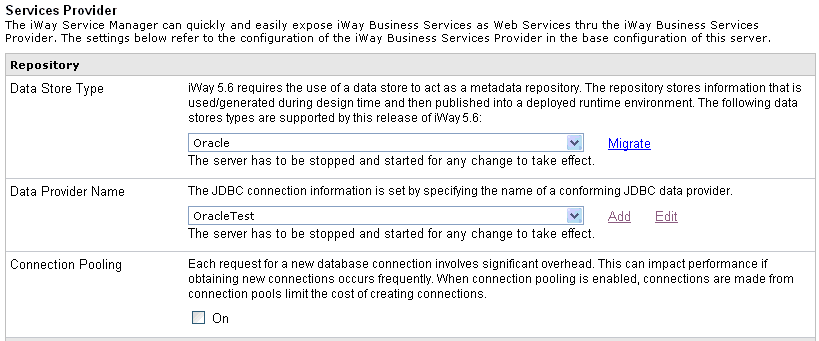
Notice the Migrate link
next to the Data Store Type drop-down list.
-
Click Migrate.
The Services Provider - Data Store Migration pane opens.

The table that is
provided is divided into two sections:
- Migration Source
- Displays the current repository that is being used.
- Migration Destination
- Displays the destination repository to which you are migrating.
-
Review
and verify all the information to make sure it is correct.
Note: To perform a clean migration, you can select
the On check box in the Reset/Clean Destination
area to delete all data that is currently in the destination repository
before proceeding.
-
Click Migrate.
Information about the migration process appears. Ensure
there are no critical errors.
After the migration completes,
iWay Business Services Provider is still set to use the source repository.
You must set it to use the destination repository instead.
-
Click Services
Provider on the left.
-
Select
the type of repository you wish to use from the Data Store Type drop-down
list.
-
Select
the connection you just defined from the Data Provider Name drop-down
list.
-
Restart
iWay Service Manager for your changes to take effect.
x
Directory providers offer access to hierarchical maps
of information. A directory might be a point in a file system or
a registry of information, such as Microsoft's Active Directory.
The directory providers offer access to information in a directory
for some purpose. For example, an LDAP provider offers generalized
access to a directory that responds to the LDAP protocol, while
other providers offer directory access for more specific purposes.
For clarity, purpose-specific directory providers appear on the
iWay Service Manager Administration Console under their purpose.
x
A directory is a set of information with similar attributes
organized in a logical and hierarchical manner. The protocol accesses
LDAP directories, regardless of the form of the directory itself.
LDAP sees the directory in a standard manner.
- A directory
is a tree of directory entries.
- An entry
consists of a set of attributes.
- An attribute
has a name (an attribute type or attribute description) and one
or more values. The attributes are defined in a schema.
- Each entry
has a unique identifier: its Distinguished Name (DN). This consists
of its Relative Distinguished Name (RDN) constructed from some attribute(s)
in the entry, followed by the parent entry's DN. Think of the DN
as a full filename and the RDN as a relative filename in a folder.
A DN may change over the lifetime of the entry, for instance,
when entries are moved within a tree. To reliably and unambiguously
identify entries, a unique key (called a UUID) may be provided in
the set of the entry's operational attributes.
iWay provides a simple access function to supply the value of
a single LDAP attribute for use as a configuration parameter. The
following function accesses the information in the directory:
_LDAP( filter, attribute, context [,providername])
For example: _LDAP("cn=John Doe",mail,'dc=example') might return
the mailing address for John.
LDAP providers may also be used to hold certificates for security operations.
x
LDAP Directory Provider as a Certificate Store Provider
An LDAP system can also be used to hold certificates
for security operations. A configured directory provider pointing
to an LDAP system can be used in the configuration of the components
that support a certificate store, such as AS2. A certificate store,
also called a certstore, is a database of public key certificates
and certificate revocation lists. An LDAP server used as a CertStone
must support anonymous access.
The structure within the LDAP must follow the RFC2587 specifications
to store the certificate information. The directory provider configuration
screen provides a test facility. This simply verifies that the specified
LDAP URL can be used to access the directory. It does not validate
security or other attributes of the directory.
x
Procedure: How to Define a Directory Provider
To
define a directory provider:
-
In the left console pane of the Server menu, select Directory
Provider.
The Directory Provider pane opens.

-
Click New in the Defined LDAP Providers section.
The Directory Providers: LDAP pane opens.
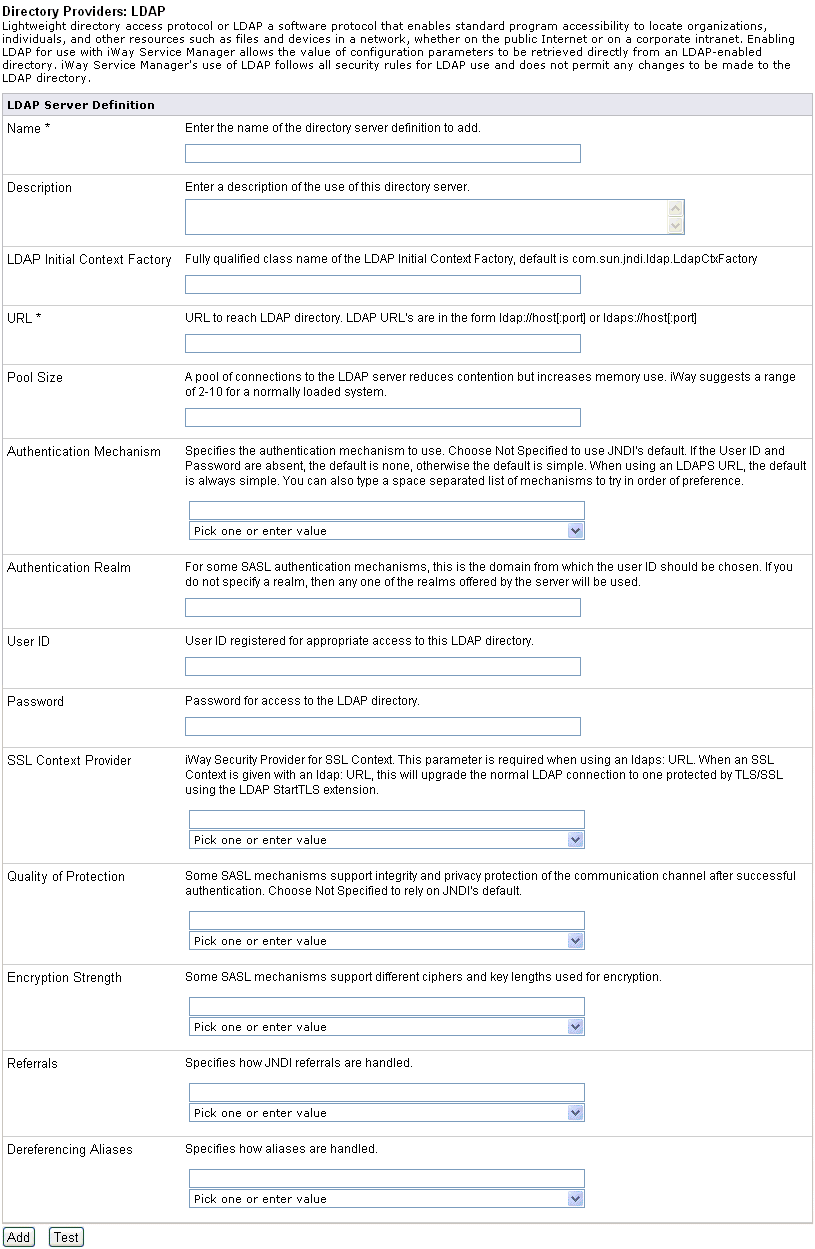
-
Provide the appropriate values for your LDAP connection
parameters as listed and defined in the following table.
|
Parameter
|
Description
|
|---|
|
Name *
|
Enter the name of the directory server definition
to add.
|
|
Description
|
Enter a description of the use of this directory server.
|
|
LDAP Initial Context Factory
|
Fully qualified class name of the LDAP Initial
Context Factory, default is com.sun.jndi.ldap.LdapCtxFactory
|
|
URL *
|
URL to reach LDAP directory. LDAP URLs are
in the form: ldap://host[:port] or ldaps://host[:port]
|
|
Pool Size
|
A pool of connections to the LDAP server
reduces contention but increases memory use. iWay suggests a range
of 2-10 for a normally loaded system.
|
|
Authentication Mechanism
|
Specifies the authentication mechanism to
use. Select Not Specified to use the JNDI default. If the User
ID and Password are absent, the default is none, otherwise
the default is simple. When using an LDAPS URL, the default
is always simple. You can also type a space separated list of
mechanisms to try in order of preference.
|
|
Authentication Realm
|
For some SASL authentication mechanisms,
this is the domain from which the user ID should be chosen. If you do
not specify a realm, then any one of the realms offered by the server
will be used.
|
|
User ID
|
User ID registered for appropriate access
to this LDAP directory.
|
|
Password
|
Password for access to the LDAP directory.
|
|
SSL Context Provider
|
iWay Security Provider for SSL Context.
This parameter is required when using an ldaps: URL. When an SSL
Context is given with an ldap: URL, this will upgrade the normal
LDAP connection to one protected by TLS/SSL using the LDAP StartTLS
extension.
|
|
Quality of Protection
|
Some SASL mechanisms support integrity and
privacy protection of the communication channel after successful authentication.
Choose Not Specified to rely on the JNDI default.
|
|
Encryption Strength
|
Some SASL mechanisms support different ciphers and
key lengths used for encryption.
|
|
Referrals
|
Specifies how JNDI referrals
are handled.
|
|
Dereferencing Aliases
|
Specifies how aliases are handled.
|
-
Click Test to test the connection
to the LDAP provider.
-
Click Add when you are finished.
You are returned to the main Directory Provider pane and
the new LDAP directory provider that was defined is added to the
list.

-
To define multiple directory providers, repeat this procedure.
A defined directory provider can be used as a named provider
during the configuration of supporting components such as AS2.
x
A cryptographic system requires a mechanism for the
storage and use of cryptographic information. For more information
on iSM security and security providers, see the iWay Service
Manager Security Guide.
A keystore is a collection of keys and certificates. There are
two types of keystore entries:
-
Key Entry. This
type of keystore entry stores sensitive cryptographic key information
in a protected format. Typically this is a secret key or a private
key with a certificate chain.
-
Trusted Certificate Entry. This
type of keystore entry contains a single public key certificate
belonging to another entity. It is called trusted because the keystore
owner trusts that the certificates belongs to the subject (owner)
of the certificate.
Entries in a keystore are referred to by their "alias", which
is a simple unique string.
A truststore is a keystore used to hold the certificate of trusted
Certificate Authorities.
A system may need to use a variety of keystores for different
purposes. iWay Service Manager identifies named keystore providers,
each of which represents one keystore and the appropriate access
credentials and algorithms needed to access that keystore's information.
The keystore provider is identified by name to other components
of the system that require access to the security information, such
as AS2 or HTTP inlets.
x
A keystore is a database of key material. Key
material is used for a variety of purposes, including authentication
and data integrity. There are various types of keystores available,
including "PKCS12" and Sun's "JKS." Some keystores can contain both
encryption keys and security certificates. Formally, however, a
keystore holds the private key for one or more PKI key pairs.
A truststore is a database of key material. It holds the
public certificates of trusted partners for message exchange. Although
it is possible to share a single file with the keystore, more formally
a truststore and a keystore are separate entities.
A certificate store, also called a certstore,
is a database of public key certificates and Certificate Revocation
Lists. The CRL is required to stop the use of a certificate when
it would otherwise be considered valid. A CRL is not needed to tell
you a certificate is bad once its expiration date is reached. In
fact, CRLs are usually cleaned of expired CRLs after one complete
CRL revision period has elapsed. This means the expired CRL will
continue to appear in at most one CRL after it expired.
If certificate revocation is turned on, you will need one CRL
for each CA in the certificate chain you want to verify. If a CRL
is missing, there is no way to know whether certificates issued
by that Certificate AUthority are still valid. Therefore, all certificates
issued by this CA will be considered revoked. A CRL that contains
no certificates is acceptable. It belongs to a Certificate Authority
that did not revoke any certificates.
x
Directory CertStore Providers
CertStore providers define the directories from which
certificates and CRLs can be loaded. A configured Directory Certstore
provider can be used as a named provider in the components that
support CRL checking for messages.
x
The following section describes LDAP certstore providers.
x
Adding Debug Information for Certstore
If you encounter issues running the LDAP Certstore provider,
you may wish to enable additional debugging. You can add the system
property -Djava.security.debug=certpath to trace what the Sun CertStores
and CertPathBuilder are doing. This will show you more information
regarding the way certificates are being loaded and used.
x
The Sun PKIX CertPathBuilder takes the RFC2587 literally
and demands that certificates in the reverse field of the crossCertificatePair
be a CA. In particular, it demands that a BasicConstraints extension
be present with maxPathLen greater or equal to 0. The End Entity
certificates are stored in the crossCertificatePair. The Basic Constraints for
an End Entity specifies that this certificate is not a CA and therefore
the maxPathLen is -1. This breaks the Sun PKIX CertPathBuilder.
As the result, if you send incomplete certificate chains to our
AS2 listener, make sure you also set the PKIX JCE Provider to BC to
make it work properly.
x
Procedure: How to Define a CertStore Directory Provider
To
define a CertStore directory provider:
-
In the left console pane of the Server menu, select Security
Provider.
The Security Provider pane opens.
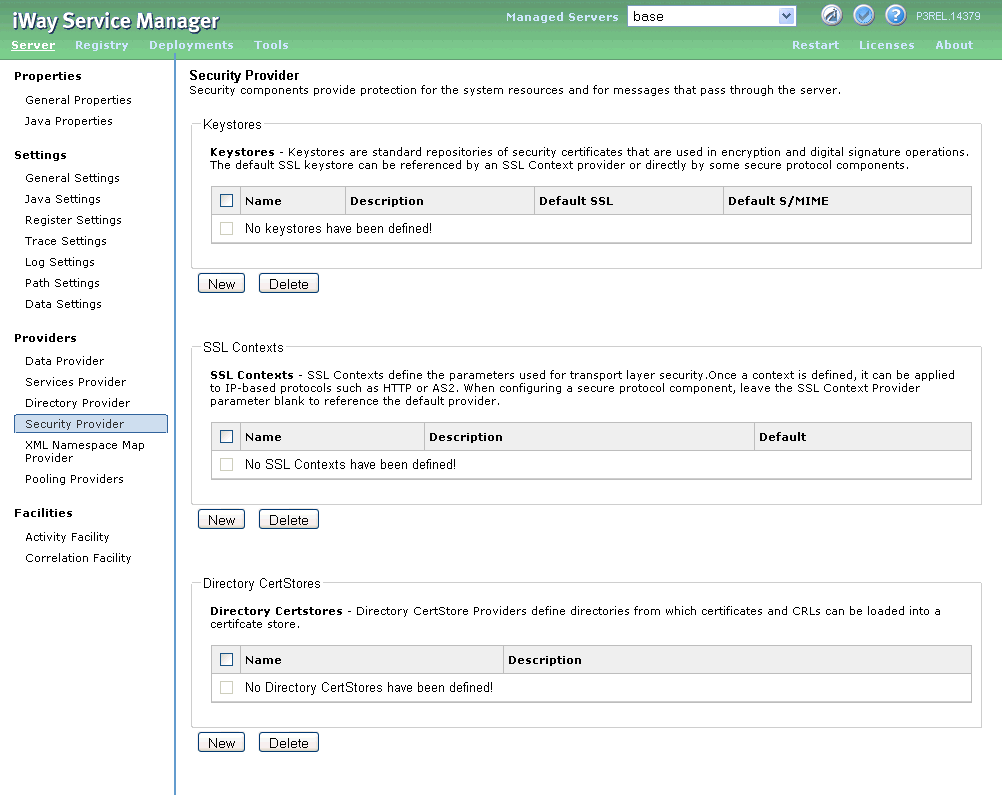
-
Click New in the Directory CertStore section.
The Directory CertStore Definition pane opens.
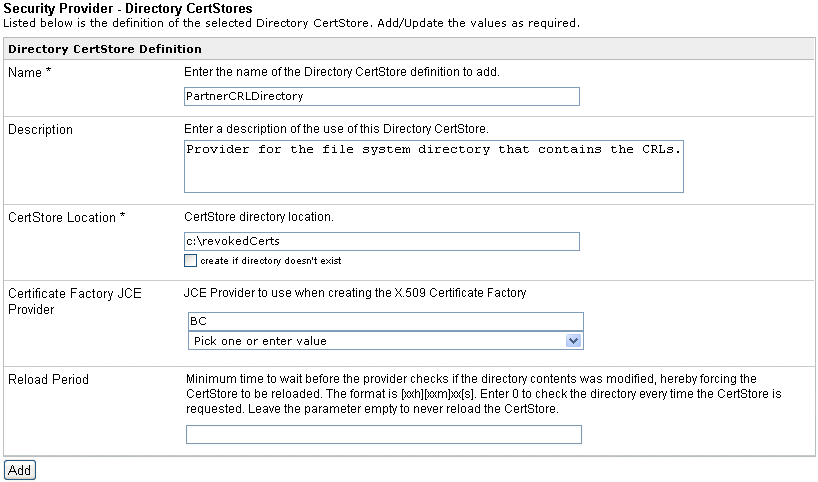
-
Provide the appropriate values for your Directory CertStore
provider parameters as listed and defined in the following table.
|
Parameter
|
Description
|
|---|
|
Name *
|
Enter the name of the Directory CertStore
definition to add.
|
|
Description
|
Enter a description of the use of this Directory CertStore.
|
|
CertStore Location *
|
CertStore directory location.
|
|
Certificate Factory JCE Provider
|
JCE Provider to use when creating the X.509 Certificate
Factory.
|
|
Reload Period
|
Minimum time to wait before the provider
checks if the directory contents was modified, hereby forcing the CertStore
to be reloaded. The format is [xxh][xxm]xx[s]. Enter 0 to check
the directory every time the CertStore is requested. Leave the parameter
empty to never reload the CertStore.
|
-
Click Add when you are finished.
You are returned to the main Security Provider pane and
the new Directory CertStore provider that was defined is added to
the list.

-
To define multiple Directory CertStore providers, repeat
this procedure.
This allows you to configure multiple CertStore directory
providers where each can have a different configuration.
A
defined CertStore directory provider can be used as a named provider
when configuring components such as AS2 that support certificate validation.
x
Keystores are standard repositories of security certificates
that are used in encryption and operations involving digital signatures.
iWay Security Provider configuration supports the creation of multiple
keystores that can be used as named providers in the corresponding
components, such as AS2 and HTTP. This allows the system to contain
multiple types of keystores which may contain different credentials,
algorithms and other configurations.
x
Procedure: How to Define a Keystore Provider
To
define a keystore provider using the iWay Service Manager Administration
Console:
-
In the left console pane of the Server menu, select Security
Provider.
The Security Provider pane opens.
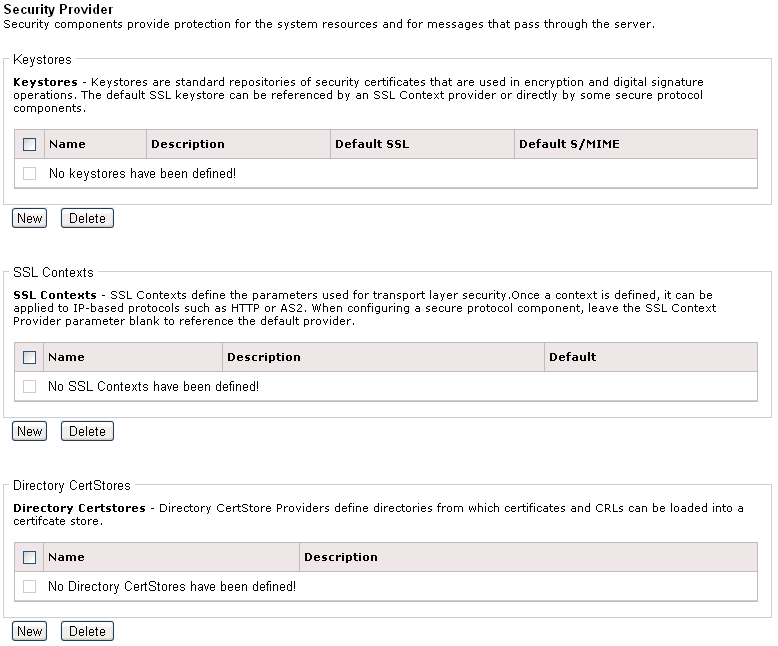
-
Click New in the Keystores section.

The Keystore Definition
pane opens.
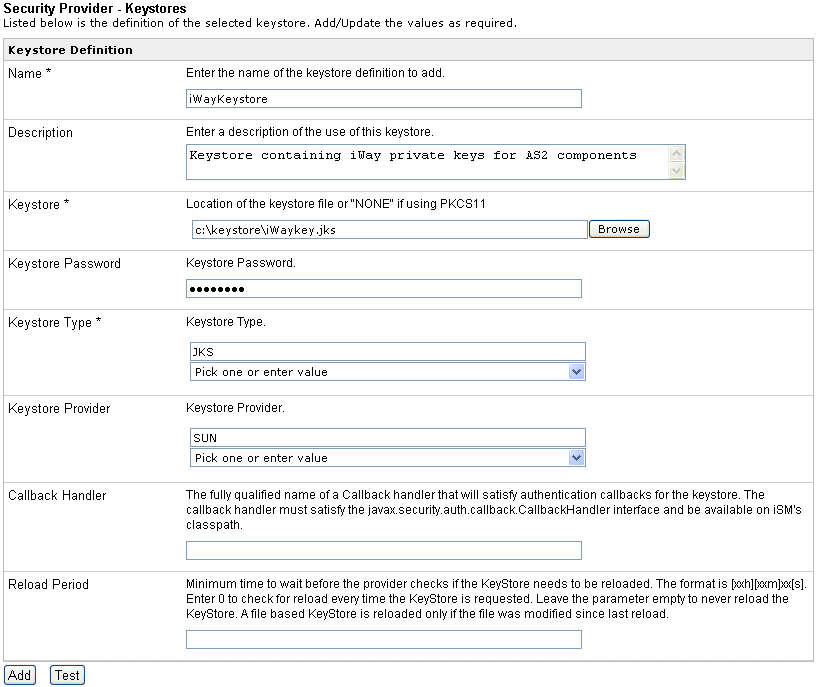
-
Enter the parameters for the keystore and make sure to select
the appropriate values from the Keystore Type and the Keystore Provider
drop-down lists that will correspond to your keystore configuration.
-
In the Callback Handler field, optionally enter the fully qualified
name of a callback handler that will satisfy authentication callbacks
for the keystore.
The callback handler must satisfy the javax.security.auth.callback.CallbackHandler interface
and be available in the classpath for iWay Service Manager.
-
Click Add.
You are returned to the main Security Provider pane and
the new keystore that was defined is added to the list.

-
To define multiple keystore providers, repeat this procedure.
A defined keystore provider can be used as a named provider
when configuring other iWay components (for example, listeners,
services, emitters, and so on).
x
Transport Layer Security (TLS) and its predecessor,
Secure Sockets Layer (SSL), are cryptographic protocols that provide
security and data integrity for communications over TCP/IP networks
such as the Internet. These protocols allows client/server applications
to communicate across a network in a manner designed to prevent
eavesdropping, tampering, and message forgery. TLS and SSL encrypt
the segments of network connections at the Transport Layer end-to-end.
In cases in which iSM requires SSL or TLS support, the appropriate
component requests the name of an SSL Context Provider.
In the typical usage, authentication is unilateral; only the
server is authenticated to the end point. That means that the client
is aware and sure of the identity of the server but not vice versa.
These protocols also support bilateral authentication, in which
both the client and the server exchange certificates and are aware
of the others identity. This is common in business interactions.
Identification is accomplished by the exchange of signed certifications
containing the URL, name and address of the end point that sends
the certificate. The certificates are in turn signed by a trusted
Certificate Authority.
Once defined, an SSL Context Provider can be associated with
one or more components (server such as nHTTP or client such as an
nHTTP emit agent) using SSL or TLS. This is done be naming the provider
in the component's configuration. The SSL Context Provider, in turn,
relies on keystore and trust store providers that have been previously configured.
The provider manages the connections and handshakes between end
points, and attempts to optimize connection reuse where possible
and consistent with communications security.
If you are configuring an SSL Context Provider to be used for
server side, you will need a Keystore Provider as the source of
your public certificate which will be recognized by the client.
If you configure your SSL Context Provider to require client client
authentication, you will need a Truststore Provider as the source
of the trusted client certificates.
If you are configuring an SSL Context Provider to be used on
the client side, you will need a Keystore Provider as the source
of your public certificate and a TrustStore Provider as the source
of the certificates of the servers to be trusted.
An SSL Context Provider requires that both be configured, even
though both may not be needed. We can not tell to which use the
Provider will be used. However if you are your application does
not require a value in one of the other (Keystore or Truststore)
the contents is not used. The format of the Keystore and Truststore
must be correct.
x
Procedure: How to Define an SSL Context Provider
To
define an SSL context provider using the iWay Service Manager Administration
Console:
-
In the left console pane of the Server menu, select Security
Provider.
The Security Provider pane opens.

-
Click New in the SSL Contexts section.
The SSL Context Provider pane opens.
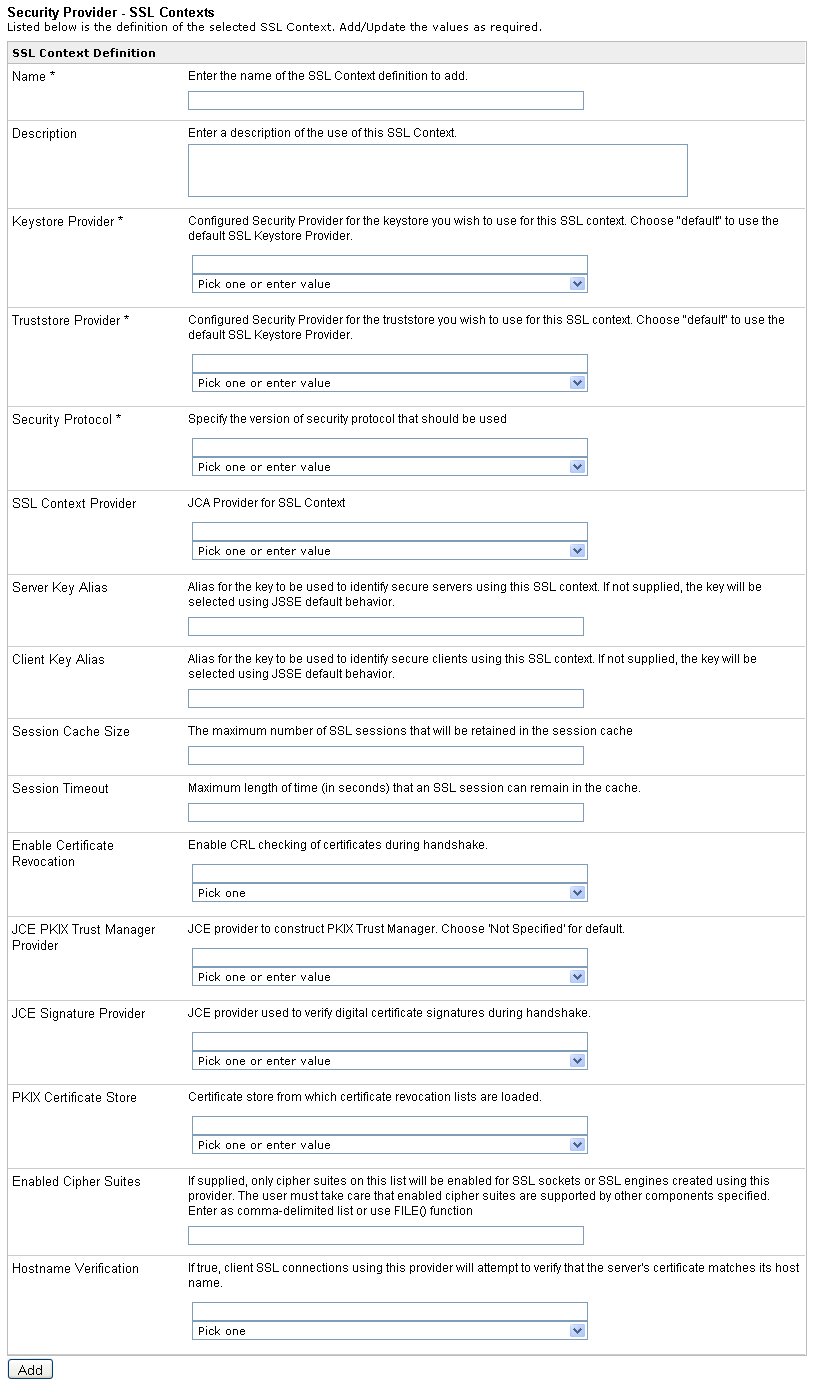
-
Enter the appropriate values for the SSL context provider parameters.
For more information, see Parameters for SSL Context Providers.
-
Click Add when you are finished.
You are returned to the main Security Provider pane and
the new SSL context provider that was defined is added to the list.

Note: To activate
any new security providers that have been configured, you must restart
iWay Service Manager.
-
To define multiple SSL context providers, repeat this procedure.
A defined SSL context provider can be used as a named provider
when configuring IP-based components such as AS2 and HTTP.
x
Reference: Parameters for SSL Context Providers
The
following table lists and describes all of the available parameters
for SSL context providers.
|
Parameter
|
Description
|
|---|
|
Name
|
Name for the SSL context provider.
|
|
Description
|
Brief description of the use of this SSL
context provider.
|
|
Keystore Provider
|
Specified security provider to be used as
a keystore for this SSL context provider. Select the available keystore
provider from the drop-down list.
|
|
Truststore Provider
|
Specified security provider to be used as
a truststore for this SSL context provider. Select the available
truststore provider from the drop-down list.
|
|
Security Protocol
|
Drop-down list options for the supported
security protocol, which include:
- SSL - General
SSL support
- SSLv2 - Supports
SSL version 2 or higher
- SSLv3 - Supports
SSL version 3
- TLS - General
TLS support
- TLSv1 - Supports
TLS version 1
|
|
SSL Context Provider
|
JCA provider for SSL context. Select one
of the following options from the drop-down list:
|
|
Server Key Alias
|
Alias for the key to be used to identify
secure servers using this SSL context. If not supplied, the key will
be selected using JSSE default behavior.
|
|
Client Key Alias
|
Alias for the key to be used to identify
secure clients using this SSL context. If not supplied, the key
will be selected using JSSE default behavior.
|
|
Session Cache Size
|
The maximum number of SSL sessions that
will be retained in the session cache.
|
|
Session Timeout
|
Maximum length of time (in seconds) that
an SSL session can remain in the cache.
|
|
Enable Certificate Revocation
|
If set to True, use the CRLs from the CertStore
to check whether the signer's certificate has been revoked.
|
|
JCE PKIX Trust Manager Provider
|
Defines the JCE provider to construct the
PKIX Trust Manager. Select one of the following values from the drop-down
list:
- NOT_SPECIFIED
{NOT_SPECIFIED}
- SunJSSE {SunJSSE}
|
|
JCE Signature Provider
|
Defines the JCE provider used to verify
the digital certificate signatures during the handshake. Select
one of the following values from the drop-down list:
- NOT_SPECIFIED
{NOT_SPECIFIED}
- SUN {SUN}
- SunRsaSign
{SunRsaSign}
- SunJSSE {SunJSSE}
|
|
PKIX Certificate Store
|
The certificate store from which certificate revocation
lists are loaded.
|
|
Enabled Cipher Suites
|
If supplied, only cipher suites on this
list will be enabled for SSL sockets or SSL engines created using this
provider. Make sure that enabled cipher suites are supported by
other components that are specified.
You can enter your values
as comma-delimited list or use the FILE() function.
|
|
Hostname Verification
|
If set to True, client SSL connections using
this provider will attempt to verify that the server's certificate matches
its host name.
|
x
XML Digital Signature JCE Providers
The XML digital signature agents use the services of
the XML digital signature JCE provider. This provider is a standard
part of JDK 1.6 and requires no special installation instructions
when running with JDK 1.6.
If you are using JDK 1.5, you must add the javax.xml.crypto.jar
file to your class path. iWay Software produced this file by compiling
(with JDK 1.5) the subset of JDK 1.6 sources that deal with XML
digital signatures. You must also declare the provider in jre/lib/security/java.security
using a line with the following form:
security.provider.N=org.jcp.xml.dsig.internal.dom.XMLDSigRI
where:
- N
Is the highest provider number already present plus one.
x
XML Namespace Map Providers
The XML namespace map provider is used to map XML namespace prefixes
to the XML namespace URIs. It is also possible to declare multiple
XML namespace map providers. Each provider can have any number of
namespace declarations. The agents that need to know namespace prefixes
have a parameter where you can enter a provider name to declare
the namespaces. This can be used to allow namespace prefixes in
XPATH expressions like /soapenv:Envelope/soapenv:Header/wsse:Security,
or it can be used in reverse to choose which prefix to use when
generating new XML content.
The following table lists a sample set of XML namespaces that
can be declared with typical prefixes:
|
Namespace Prefix
|
Namespace URI
|
|---|
ds |
http://www.w3.org/2000/09/xmldsig# |
ec |
http://www.w3.org/2001/10/xml-exc-c14n# |
saml |
urn:oasis:names:tc:SAML:1.0:assertion |
soapenv |
http://schemas.xmlsoap.org/soap/envelope/ |
wsa |
http://schemas.xmlsoap.org/ws/2004/08/addressing |
wsse |
http://docs.oasis-open.org/wss/2004/01/oasis-20040
1-wss-wssecurity-secext-1.0.xsd |
wsu |
http://docs.oasis-open.org/wss/2004/01/oasis-20040
1-wss-wssecurity-utility-1.0.xsd |
xsd |
http://www.w3.org/2001/XMLSchema |
xsi |
http://www.w3.org/2001/XMLSchema-instance |
You can access the XML Namespace Map Provider window in the iWay
Service Manager Administration Console to construct an XML namespace
map.
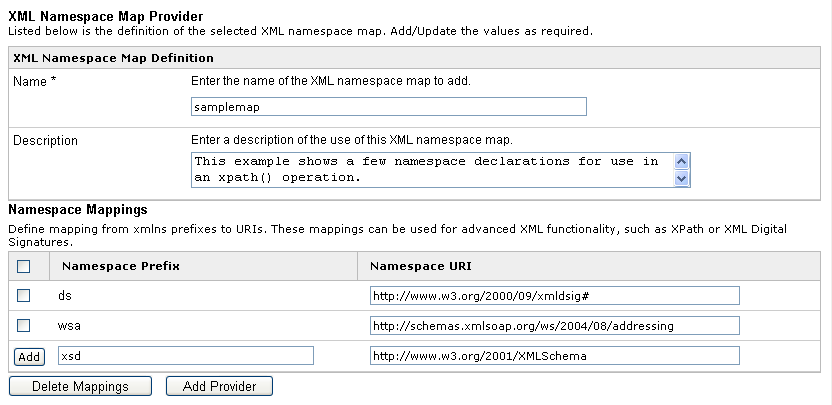
In this example, two XML namespace maps have been added and a
third one is in the process of being defined. When you are finished,
click Add Provider to make the XML namespace
map available.
Once the map is complete, the following XPATH function will locate
the y element in a document where the wsa namespace defined in the
map matches the namespace URI for that element in the actual document:
xpath('/x/wsa:y', samplemap)Note: It is not required for the namespace prefix in the
map to match the actual namespace prefix used in the target document.
x
NHTTP Emit and HttpClient Providers
The HttpClient provider allows HTTP connections to be
shared among iWay Service Manager components. An instance of the
HttpClient provider represents a pool of connections. Connections
in this pool can share proxy settings, local interface bindings, and,
for HTTPS, a single SSL socket factory. Currently, the provider
is used by the NHTTP and NAS2 emitters, as well as by the NAS2 MDN
subsystem for sending asynchronous MDN messages via HTTP.
x
Procedure: How to Define NHTTP and HttpClient Providers
To
define NHTTP and HttpClient providers:
-
In the left console pane of the Server menu, select Pooling
Providers.
The Pooling Providers pane opens.

-
Click New in the Defined HttpClient
Providers section.
The HttpClient Provider Settings pane opens.
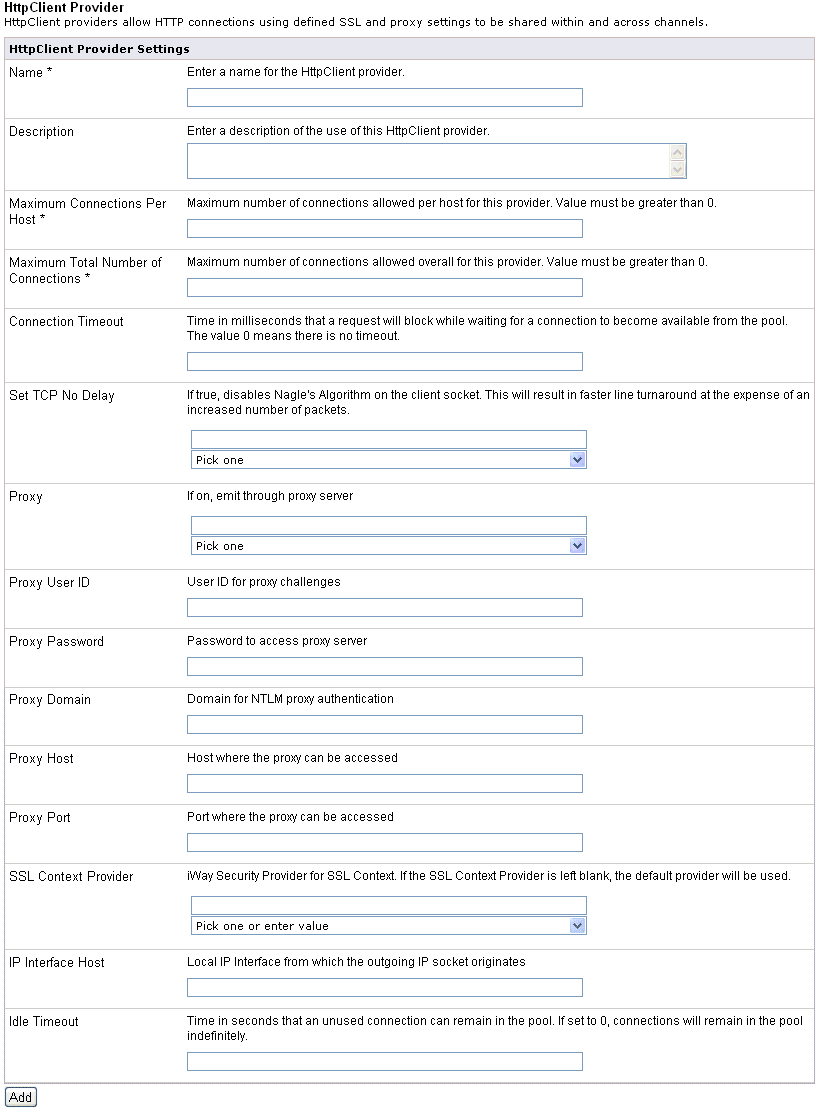
-
Enter the appropriate values for the HttpClient Provider parameters.
-
Click Add when you are finished.
You are returned to the main Pooling Providers pane and
the new HttpClient Provider that was defined is added to the list.
-
To define multiple Pooling Providers, repeat this procedure.
x
Reference: Parameters for HttpClient Providers
The
following table lists and describes all of the available parameters
for HttpClient providers.
|
Parameter
|
Description
|
|---|
|
Name *
|
Name for the HttpClient provider.
|
|
Description
|
Brief description of the use of this HttpClient provider.
|
|
Maximum Connections Per Host *
|
Defines the maximum number of simultaneous connections
allowed per host. When this threshold is reached, new connections
will not be accepted until current connections are closed and the
total number of connections is below the limit. Leave this field
blank (default) or set a value of zero to have no maximum limit
of connections.
|
|
Maximum Total Number of Connections *
|
Defines the maximum number of simultaneous connections
that are allowed overall. When this threshold is reached, new connections
will not be accepted until current connections are closed and the
total number of connections is below the limit. Leave this field
blank (default) or set a value of zero to have no maximum limit
of connections.
|
|
Connection Timeout
|
Maximum length of time (in milliseconds)
that a request will block while waiting for a connection to become
available from the pool. The value 0 means there is no timeout.
|
|
Set TCP No Delay
|
If set to True, disables Nagle's Algorithm
on the client socket. This will result in faster line turnaround
at the expense of an increased number of packets.
|
|
Proxy
|
If set to True, emit through a proxy server.
|
|
Proxy User ID
|
User ID for the proxy challenges.
|
|
Proxy Password
|
Password to access the proxy server.
|
|
Proxy Domain
|
Domain for NTLM proxy authentication.
|
|
Proxy Host
|
Host where the proxy can be accessed.
|
|
Proxy Port
|
Port where the proxy can be accessed.
|
|
SSL Context Provider
|
Named iWay Security provider for SSL Context.
Defaults to the value assigned to the SSL Context Provider.
|
|
IP Interface Host
|
Local IP Interface from which the outgoing
IP socket originates.
|
|
Idle Timeout
|
Time in seconds that an unused connection
can remain in the pool. If set to 0, connections will remain in
the pool indefinitely.
|
x
In version 6.0.1, iWay Service Manager supports pervasive
use of authorization realms. Authorization Realms are used to associate
Users with Roles and to control user access to resources. Realms
are established by logon activities. For example, an HTTP authentication
and authorization will establish a realm for the handling of the arriving
traffic. The server supports establishment of named realms, each
of which can be associated with a login-type operation by its name.
The realm associates a user name with the associated credentials
to authenticate the user, and to associate that user with named realm
tokens.
Available realm types include:
-
Properties Realm which authorizes through a standard
properties file. This realm is very simple to manage and is usually
associated with demonstration systems or testing.
The properties
file holds <username>=<password> (in clear) and <username>.role<n>=rolename
For
example, if sheila is a user with password amanda,
and two roles, her file entries could be:
sheila=amanda
sheila.role0=superuser
sheila.role1=admin
-
LDAP Realm which authorizes through an LDAP directory.
The LDAP is accessed through a previously defined LDAP Provider.
-
JDBC Realm which authorizes through an relational data
base. Theater base is accessed through ajar context provider, which
can be a previously defined Data Provider
-
Console Realm which authorizes through the identities
defined for console user access
-
JAAS Realm which authorizes through a standard Java Authentication and
Authorization Service (JAAS). JAAS is an abstraction layer between
the server and disparate underlying authentication and authorization
mechanisms. Many commercial systems implement the JAAS interface;
all documentation for use and setup are obtained through the various
commercial packages that implement JAAS.
The authorization name and credential, along with the roles associated
with that user under that credential, define a principal which is
the standard name for this identity. The current principal, including
the name and credential (usually a password) and the associated roles
can be examined through the iWay Functional Language (iFL) expressions.
For example, a process flow can take appropriate branches depending
upon whether or not the principal supports a specific role.
x
iWay Data Quality Center (DQC) is an essential tool
for complex data quality management. iWay DQC is designed not only
to evaluate, monitor, and manage data quality in different information
systems, but also to prevent incorrect data from entering these
systems in the first place. iWay DQC is bundled with a specific
set of business rules and localized dictionaries.
iWay Data Quality Center (DQC) is integrated with iWay Service
Manager (iSM) through the Data Quality Provider. This Provider is
used to reference a DQC plan and to manage a pool of execution threads
if required. All iSM components invoke DQC using a defined Data Quality
Provider. In addition, you can configure one or more Providers,
each representing a specific DQC Plan.
For more information about using iWay DQC, see the iWay
Data Quality Center Getting Started documentation and iWay
Data Quality Center User's Guide.
























